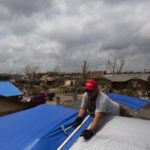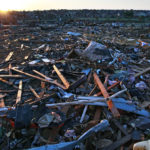Editor’s note: To see what the Red Cross has been doing in Moore, OK for the recovery process, click here: Red Cross Continues to Help Oklahoma Recover after Tornadoes
Two weeks ago my family and I drove from College Station, Texas to Lincoln, Nebraska. We’ve made this 800+ mile trek many times, and as a result, we no longer pay very close attention to the towns through which we drive and/or the scenery (or lack there of) that flies past our windows at 75 miles per hour.
 After a long and exhausting day in the car our focus was on finding a place to stop for dinner, so much so that we barely noticed that first house covered by a massive blue tarp. But the second, third, and fourth houses – all wearing temporary blue tarps instead of permanent roofs – attracted our attention. My husband wondered aloud if a storm had passed through the area recently, and then a few seconds later added that if he were a betting man, he’d wager that a tornado was responsible for the four roof-less houses on the side of the road. I agreed.
After a long and exhausting day in the car our focus was on finding a place to stop for dinner, so much so that we barely noticed that first house covered by a massive blue tarp. But the second, third, and fourth houses – all wearing temporary blue tarps instead of permanent roofs – attracted our attention. My husband wondered aloud if a storm had passed through the area recently, and then a few seconds later added that if he were a betting man, he’d wager that a tornado was responsible for the four roof-less houses on the side of the road. I agreed.
As my eyes shifted from the right-hand side of the car to the left, the scene on which they came to rest elicited an involuntary and audible gasp from my lips. My husband followed my gaze out his window, and when his eyes landed on what I’d just seen he whispered, “oh my gosh…”
We knew immediately that the awkward and haphazard destruction at which we stared was not manmade. Despite the fact that both my husband and I grew up in the Midwest – where severe storms and tornadoes are not uncommon – neither of us had ever seen tornado damage up close. And despite the fact that neither of us had ever seen tornado damage up close, we both knew we were looking at some of the most wide-spread and deadly devastation ever caused by tornadoes.
I glanced down at the United States Atlas, which lay open on my lap, and traced the route we’d driven that day. A few seconds later, my finger came to an abrupt stop over the bold text: “Moore”.
 We were driving through Moore, Oklahoma, one month – to the day – after the community had been ravaged by tornadoes.
We were driving through Moore, Oklahoma, one month – to the day – after the community had been ravaged by tornadoes.
Like most Americans, I followed the news coverage of the storms in Moore every day for nearly a week. And like most Americans, when the media started covering the “next big thing”, I unintentionally forgot about Moore.
This is pretty common, actually. When stories of natural or manmade disasters take their turn in the limelight, we pay close attention. We donate to fulfill the needs – from blood to food and clothing to money – of the communities affected and encourage others to do the same. But as soon as these disasters transition from center stage to the wings, we forget. We move on.
What I saw when I drove through Moore, Oklahoma, reminded me that we shouldn’t – we can’t – move on yet. We shouldn’t move on after the tornados in Oklahoma, Superstorm Sandy in New Jersey, or even Hurricane Katrina along the Gulf Coast…until our help is no longer needed.
Keep the people and communities affected in your thoughts. Honor those who continue to struggle by donating blood, taking a class, or volunteering. Consider supporting the recovery and rebuilding efforts with your financial donations.
But whatever you do, don’t forget.
